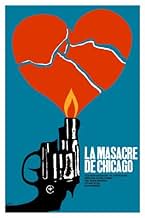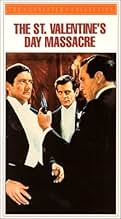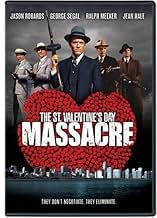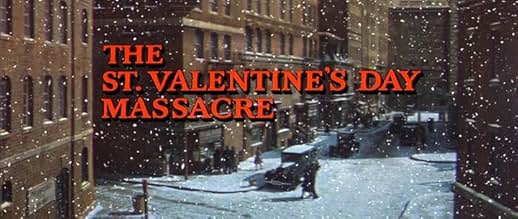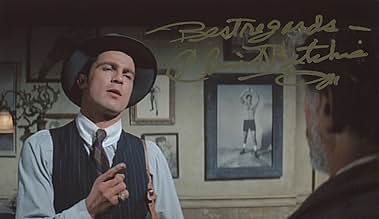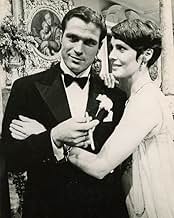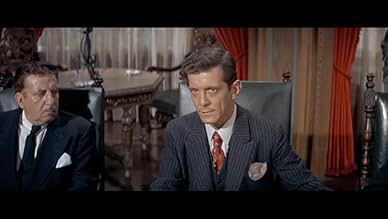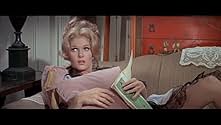Il massacro del giorno di San Valentino
Titolo originale: The St. Valentine's Day Massacre
VALUTAZIONE IMDb
6,6/10
5051
LA TUA VALUTAZIONE
Aggiungi una trama nella tua linguaAl Capone's Valentine's Day surprise for the rival Bugs Moran gang in 1929 Chicago.Al Capone's Valentine's Day surprise for the rival Bugs Moran gang in 1929 Chicago.Al Capone's Valentine's Day surprise for the rival Bugs Moran gang in 1929 Chicago.
- Regia
- Sceneggiatura
- Star
Joe Turkel
- Jake 'Greasy Thumb' Guzik
- (as Joseph Turkel)
Recensioni in evidenza
If you love movies, this Roger Corman entry into the gangster genre is a revelation. The story is told in a series of loosely connected episodes that supposedly document real circumstances leading up to the St. Valentine's Day Massacre. A narrator tells us what we need to know for each scene, moving the action forward with an astonishing speed and clarity. Corman stamps the Docudrama style with this convention, and it really works; the immediate story is constantly informed by the narrator's voice-of-god telling of characters' past, present, and future circumstances. Even though the visual dimension of the film never escapes its studio locations, Corman's staging and his work with the actors gives it a sense of urgency. Corman has never really been talked about as an actor's director, but here he apparently had the time, the script, and I assume the inclination to let the players rip through the ceiling. The performances are all terrific. Jason Robards (looking nothing like Al Capone!) has an insane, maniacal smile that is often more unsettling than his violent rages. The camera seems to follow him around without the interruption of a cut; his mood swings keep his men in line and the viewer disarmed. True, Robards carries on, but it seems appropriate for the movie. George Segal has two great scenes that seem to play out without interruption. The one with Barbara Hale is a doozy. In fact, all through the film, Corman showcases characters in often ironic situations creating a tapestry of collective behavior that gives the film an amazing sense of vitality. Its the odd, subjective character detail that builds this story; we get involved not in the melodramatics of the story, per se, but rather in the lives of those individuals that come together who create the story.
In a very real way, Corman's approach pre-figures and creates the template for Coppola's internal view of the Mafia in the GODFATHER movies. It lacks the scope of Coppola's saga, for sure. But it sets the precedent. Corman was a terrific director. This movie was the only one he did for a major studio, 20th Century Fox. As a director, a major studio suited Corman, the artist. But as a producer, Corman has written about his distain for studio waste and book keeping. So for the next few years, before giving up directing altogether, Corman continued to work on his own under his safe and financially responsible American International umbrella. If you love movies, this is one you will cherish. Please give it a look. It a rich, satisfying, and disarmingly complex little gangster movie; terrifically entertaining.
In a very real way, Corman's approach pre-figures and creates the template for Coppola's internal view of the Mafia in the GODFATHER movies. It lacks the scope of Coppola's saga, for sure. But it sets the precedent. Corman was a terrific director. This movie was the only one he did for a major studio, 20th Century Fox. As a director, a major studio suited Corman, the artist. But as a producer, Corman has written about his distain for studio waste and book keeping. So for the next few years, before giving up directing altogether, Corman continued to work on his own under his safe and financially responsible American International umbrella. If you love movies, this is one you will cherish. Please give it a look. It a rich, satisfying, and disarmingly complex little gangster movie; terrifically entertaining.
When I first saw "The St. Valentine's Day Massacre" in 1967, I never would have guessed that legendary B movie maestro Roger Corman's attempt to break into the big-time would become one of my favorite films, but it did for a time. Ah, the innocence of youth. All that blood-letting in the big massacre scene appealed to my ghoulish instincts, and the semi-documentary approach made it feel like a history lesson. Watching the film on video recently, I still enjoyed it and was once more pleased to hear Alfred Newman's score, complete with an off-key piano (meant to symbolize the gangsters' rejection of law and order?), but now I see the film for what it is: a B movie in A movie dress; a film as realistic as the black and white gangster movies churned out by Warner Bros. in the 1930s.
The tone is slightly comic, especially when big Al affectionately glides his fist across the face of Jack McGurn, his favorite among the cutthroats on his payroll, and Jack shyly grins in appreciation. It is as hokey as George Raft tossing a silver dollar in the air in 1932's "Scarface."
The acting is over the top, of course, with Jason Robards, an uncharacteristically slim Capone, chewing the scenery, as they say, slamming his fist on his desk, bulging his eyes and shouting even his calmest utterances. George Segal seems to be imitating Cagney while the rest of the cast chews gum so often that you know if this film had been made today, Juicy Fruit would have a piece of the action by way of an official tie-in. In the midst of all this ham, Ralph Meeker manages to etch a subdued and believable portrait of Bugs Moran that easily claims the acting honors. In a small role as a mechanic, Bruce Dern also shines. Jack Nicholson is briefly glimpsed and even more briefly heard explaining why hitmen wipe garlic on their bullets ("If the bullets don't kill you..."), and he, too, echoes earlier caricatures of movie mobsters by speaking his one line in a silly rasp.
"The St. Valentine's Day Massacre" is a pleasant enough diversion for those who fondly recall their first exposure to Cagney and Bogart in "The Roaring Twenties" or scores of other gangster classics. But it's nothing more than that, and the shame is that it could have been much more. A more restrained, serious approach could have made it a precursor of sorts to "The Godfather" and "Goodfellas." Instead, it's a live action cartoon.
The tone is slightly comic, especially when big Al affectionately glides his fist across the face of Jack McGurn, his favorite among the cutthroats on his payroll, and Jack shyly grins in appreciation. It is as hokey as George Raft tossing a silver dollar in the air in 1932's "Scarface."
The acting is over the top, of course, with Jason Robards, an uncharacteristically slim Capone, chewing the scenery, as they say, slamming his fist on his desk, bulging his eyes and shouting even his calmest utterances. George Segal seems to be imitating Cagney while the rest of the cast chews gum so often that you know if this film had been made today, Juicy Fruit would have a piece of the action by way of an official tie-in. In the midst of all this ham, Ralph Meeker manages to etch a subdued and believable portrait of Bugs Moran that easily claims the acting honors. In a small role as a mechanic, Bruce Dern also shines. Jack Nicholson is briefly glimpsed and even more briefly heard explaining why hitmen wipe garlic on their bullets ("If the bullets don't kill you..."), and he, too, echoes earlier caricatures of movie mobsters by speaking his one line in a silly rasp.
"The St. Valentine's Day Massacre" is a pleasant enough diversion for those who fondly recall their first exposure to Cagney and Bogart in "The Roaring Twenties" or scores of other gangster classics. But it's nothing more than that, and the shame is that it could have been much more. A more restrained, serious approach could have made it a precursor of sorts to "The Godfather" and "Goodfellas." Instead, it's a live action cartoon.
It's incredible to think that this film, Roger Corman's major studio debut, and THE GODFATHER (made by Corman alumnus Coppola) were made within five years of each other. They could be decades apart, in look, in sensibility, in impact. Whereas GODFATHER gropes for a rich, mythic timelessness, MASSACRE seems brittle, thin, a mere pastiche of, variously, 30s Warners gangster films, 40s B-movies, or Corman's own early work. Whereas Coppola's characters have passed into popular culture, Corman's gangsters are thinly characterised, theatrical, parodic; whereas GODFATHER's plot is slow-burning, tense, silent, punctuated with shocking shards of tangible violence, MASSACRE is almost cartoon-like in its relentless gunfire, which, because it's not rooted in character, does not have as traumatic an effect.
Some of us, however, might recoil a little from the major film's more questionable posturing, and MASSACRE has many excellencies. Most immediately pleasurable is the plot, mathematically simple, as Corman narrates the titular bloodbath like a theorem, showing A (Capone) meeting B (Moran) to create C (the massacre). QED. Nothing is allowed interfere with this beautiful simplicity - every scene, every character, every action refers to this theorem alone. Even scenes which seem to illustrate character (eg Peter Gusenberg and Myrtle) only do so to 'explain' why one side got the better of another.
This quality extends to the film as a whole, which is a series of repetitions and mirroring scenes. Another pleasure is the voiceover, which again transforms a conventional narrative about real people into abstract formalism. Like a voice of God, it intrudes without warning, frequently, mixing bald factual details about all the players (eg Such and such, born 1893 in such a place, suspected gun-runner, killer etc., will die on 3 May 1957 of heart failure) with speculation. Before any character has even begun their parts in the film, their life stories are known to us. This robs them of everything that makes us human - motivation, hope, action. Sartre said we are what we do. Not here. Robbed of human characteristics, they become mere ciphers, playing out their inevitable fates, and denying the viewer the kind of emotional empathy that Coppola will dubiously over-indulge in.
Despite the (relatively) high budget, production values do nothing to make the film more realistic. Indeed, the uniformity of colour (predominantly grey), the repetition of scenes and places, the reduction of sequences to sheer functionality, makes the film increasingly artificial. The theatricality of the acting adds to this, with Robards especially hamming away to amusingly grand effect, but theatricality is embedded too, as narratively crucial scenes become sites for rhetoric, oratory, dramatic performance, an actor declaiming to an enrapt public, hanging (for dear life) to his every word.
Add to all this Corman's stunning, playful direction, confident and fluid, making interiors and objects live, fixing characters in their place. The violent scenes are expertly choreographed, if they aren't disturbing, their formal excellence is undiminished. All this formalism is not an empty, academic exercise. By revealing the phoniness of his subject matter, Corman reveals the processes of myth-making that, especially through the cinema, curiously glamourised an era, when America was in thrall to a number of violent fascists.
Corman is not seriously moralistic, he is cheerfully aware of human nature's strange pulls - he shows how the need for violence and sensation in cinema is close to the fascistic, but also undeniable. It is a trap Coppola doesn't always avoid. The score, which makes ragtime eerily modernist, is astounding, while Corman reveals, as in TALES OF TERROR, that he has a canny sense of the domestic's comic violence - the Pete/Myrtle scene is a hilarious-troubling classic.
Some of us, however, might recoil a little from the major film's more questionable posturing, and MASSACRE has many excellencies. Most immediately pleasurable is the plot, mathematically simple, as Corman narrates the titular bloodbath like a theorem, showing A (Capone) meeting B (Moran) to create C (the massacre). QED. Nothing is allowed interfere with this beautiful simplicity - every scene, every character, every action refers to this theorem alone. Even scenes which seem to illustrate character (eg Peter Gusenberg and Myrtle) only do so to 'explain' why one side got the better of another.
This quality extends to the film as a whole, which is a series of repetitions and mirroring scenes. Another pleasure is the voiceover, which again transforms a conventional narrative about real people into abstract formalism. Like a voice of God, it intrudes without warning, frequently, mixing bald factual details about all the players (eg Such and such, born 1893 in such a place, suspected gun-runner, killer etc., will die on 3 May 1957 of heart failure) with speculation. Before any character has even begun their parts in the film, their life stories are known to us. This robs them of everything that makes us human - motivation, hope, action. Sartre said we are what we do. Not here. Robbed of human characteristics, they become mere ciphers, playing out their inevitable fates, and denying the viewer the kind of emotional empathy that Coppola will dubiously over-indulge in.
Despite the (relatively) high budget, production values do nothing to make the film more realistic. Indeed, the uniformity of colour (predominantly grey), the repetition of scenes and places, the reduction of sequences to sheer functionality, makes the film increasingly artificial. The theatricality of the acting adds to this, with Robards especially hamming away to amusingly grand effect, but theatricality is embedded too, as narratively crucial scenes become sites for rhetoric, oratory, dramatic performance, an actor declaiming to an enrapt public, hanging (for dear life) to his every word.
Add to all this Corman's stunning, playful direction, confident and fluid, making interiors and objects live, fixing characters in their place. The violent scenes are expertly choreographed, if they aren't disturbing, their formal excellence is undiminished. All this formalism is not an empty, academic exercise. By revealing the phoniness of his subject matter, Corman reveals the processes of myth-making that, especially through the cinema, curiously glamourised an era, when America was in thrall to a number of violent fascists.
Corman is not seriously moralistic, he is cheerfully aware of human nature's strange pulls - he shows how the need for violence and sensation in cinema is close to the fascistic, but also undeniable. It is a trap Coppola doesn't always avoid. The score, which makes ragtime eerily modernist, is astounding, while Corman reveals, as in TALES OF TERROR, that he has a canny sense of the domestic's comic violence - the Pete/Myrtle scene is a hilarious-troubling classic.
8qrt7
Taking a step back from the intellectual surmising involving Godfather, Goodfellas et al., I thought this was an enjoyable film, 'a live action cartoon' as it was put.
Yep, sure it was a tad formulaic with characters going about their predetermined business and the armchair historians knew the conclusion of the film before it happened. I accept this as valid criticism, but I would stress more that it is supposed to be a quasi-documentary, with the solemn narrator venting sparse mechanical facts about each character and their relevance to the bigger picture as they were introduced. The film itself wasn't trying (I felt) to make a big artistic or intellectual statement, just an enjoyable and disposable piece of cinema. I think that it would be worse if it had been trying top make a 'big point' but fell on its arse, which a number of mobster-related films are guilty of.
As an enjoyable 'get on and enjoy the ride' movie I think it succeeded very well. Having only a basic knowledge of prohibition gangsterland, I found it quite gripping and that the documentary style enhance my enjoyment of an otherwise complex background. The set was also very well done, though Capone was miscast.
I would recommend this to most, unless they are Godfather fans!
8/10
Yep, sure it was a tad formulaic with characters going about their predetermined business and the armchair historians knew the conclusion of the film before it happened. I accept this as valid criticism, but I would stress more that it is supposed to be a quasi-documentary, with the solemn narrator venting sparse mechanical facts about each character and their relevance to the bigger picture as they were introduced. The film itself wasn't trying (I felt) to make a big artistic or intellectual statement, just an enjoyable and disposable piece of cinema. I think that it would be worse if it had been trying top make a 'big point' but fell on its arse, which a number of mobster-related films are guilty of.
As an enjoyable 'get on and enjoy the ride' movie I think it succeeded very well. Having only a basic knowledge of prohibition gangsterland, I found it quite gripping and that the documentary style enhance my enjoyment of an otherwise complex background. The set was also very well done, though Capone was miscast.
I would recommend this to most, unless they are Godfather fans!
8/10
It took me a while before I really appreciated this film. Despite its flaws, this is probably the most serious, accurate, and restrained treatment on the subject you're ever going to get without watching a straight-out documentary. What you have is sort of a "docudrama" on the infamous St. Valentine's Massacre, and the events leading up to it.
Not that the film ST. VALENTINE'S DAY MASSACRE takes itself too seriously. It doesn't, but all of the over-the-top acting merely enhances the product. There are still some inaccuracies but the story adheres so closely to the actual facts that these discrepancies are easily forgiven. The violence shown might have been considered sensational in 1967, and this was most probably the intent, but it's pretty tame by today's standards. And if it falls short of being a great film, it's a near miss rather than one by a mile.
In this dramatization of the final showdown between the South Side and North Side gangs for control of Chicago's underworld in 1929, Jason Robards takes center stage as Al Capone. He might have been much older and looked nothing like the real Capone but then so what. As they say, you want an interpretation and not an impersonation. His histrionic performance, with all of its eye-rolling and exaggeration, strikes just the right note and does its part to help keep things moving throughout. This was an actor who knew what he was doing, and exactly how he should play it in this instance.
But it takes a while for Capone to show up, finally seen casually arriving in a limousine on his way to a board meeting with his underlings. The first hood to show up on screen is played (some could say overplayed) by George Segal as Pete Gusenberg, a member of the rival gang, who proceeds to intimidate a bar-owner. Actually, Segal gives a rather convincing performance as a very smug, arrogant thug who enjoys pushing people around, and acting like he's one bad dude, with guns and a gang to back him up.
A very effective technique employed throughout the film, provided by narrator Paul Frees, is the frequent voiceover commentary on various characters. Information is given, such as that the individual was born on this or that date, at whatever place, something about his background, and his place in the particular gang, etc. (often including his time of death as well). Not only does this provide an easily-understood guide for who's who, but it helps to get the viewer involved with these characters however unsympathetic or unsavory they might be.
In brief but well-played roles, on the Capone side, there's Paul Richards as Charlie Fischetti, Joseph Turkel as Jake Guzik, and Harold Stone as Frank Nitti, with a more conspicuous role played by Clint Richie as Jack McGurn, who gets put in charge of organizing the title massacre. That particularly bloody episode was designed to rid Capone of his archenemy and chief rival, George "Bugs" Moran, capably played by tough-talking Ralph Meeker. Moran was the head of the North Side gang, and in flashback scenes we're shown what befell Moran's two predecessors, Dion O'Bannion (played by John Agar) and Hymie Weiss (played by Reed Hadley).
The rest of the cast is made up of many fine actors, some familiar and others less so. Among the unlucky seven who have an appointment up against a certain garage wall, besides Segal's Pete Gusenberg, included are David Canary as Pete's brother Frank, Kurt Krueger as Moran's top lieutenant, Milton Frome as the gang's accountant, Joseph Campanella as a low-level employee, Bruce Dern as a mechanic, and Mickey Deems as a hanger-on. Not to be overlooked is the always excellent Frank Silvera as Nick Sorello, a not completely innocent pawn used in trying to set up Moran.
Almost every actor with a speaking role gets at least one good scene and a chance to shine, from the major actors right on down to several of the minor supporting players. An attempt is made to show some of the camaraderie and interaction among the members of each gang. The careful planning of the "hit" is laid out, including an amusing scene where two gunmen, posing as musicians, are renting a room from a wary landlady.
Such details add to the plot and the characterizations, with keen attention being paid to recreating a 1920s atmosphere, and don't forget all of the various gunplay and assorted mayhem along the way, leading up to the fateful massacre. They even throw in a completely superfluous fight between Gusenberg (Segal) and his girlfriend over a fur coat. Since it's only a brief rest from the action, and we get to rest our eyes on Jean Hale, then what's the harm. Enjoy this trip back in time to gangland Chicago.
Not that the film ST. VALENTINE'S DAY MASSACRE takes itself too seriously. It doesn't, but all of the over-the-top acting merely enhances the product. There are still some inaccuracies but the story adheres so closely to the actual facts that these discrepancies are easily forgiven. The violence shown might have been considered sensational in 1967, and this was most probably the intent, but it's pretty tame by today's standards. And if it falls short of being a great film, it's a near miss rather than one by a mile.
In this dramatization of the final showdown between the South Side and North Side gangs for control of Chicago's underworld in 1929, Jason Robards takes center stage as Al Capone. He might have been much older and looked nothing like the real Capone but then so what. As they say, you want an interpretation and not an impersonation. His histrionic performance, with all of its eye-rolling and exaggeration, strikes just the right note and does its part to help keep things moving throughout. This was an actor who knew what he was doing, and exactly how he should play it in this instance.
But it takes a while for Capone to show up, finally seen casually arriving in a limousine on his way to a board meeting with his underlings. The first hood to show up on screen is played (some could say overplayed) by George Segal as Pete Gusenberg, a member of the rival gang, who proceeds to intimidate a bar-owner. Actually, Segal gives a rather convincing performance as a very smug, arrogant thug who enjoys pushing people around, and acting like he's one bad dude, with guns and a gang to back him up.
A very effective technique employed throughout the film, provided by narrator Paul Frees, is the frequent voiceover commentary on various characters. Information is given, such as that the individual was born on this or that date, at whatever place, something about his background, and his place in the particular gang, etc. (often including his time of death as well). Not only does this provide an easily-understood guide for who's who, but it helps to get the viewer involved with these characters however unsympathetic or unsavory they might be.
In brief but well-played roles, on the Capone side, there's Paul Richards as Charlie Fischetti, Joseph Turkel as Jake Guzik, and Harold Stone as Frank Nitti, with a more conspicuous role played by Clint Richie as Jack McGurn, who gets put in charge of organizing the title massacre. That particularly bloody episode was designed to rid Capone of his archenemy and chief rival, George "Bugs" Moran, capably played by tough-talking Ralph Meeker. Moran was the head of the North Side gang, and in flashback scenes we're shown what befell Moran's two predecessors, Dion O'Bannion (played by John Agar) and Hymie Weiss (played by Reed Hadley).
The rest of the cast is made up of many fine actors, some familiar and others less so. Among the unlucky seven who have an appointment up against a certain garage wall, besides Segal's Pete Gusenberg, included are David Canary as Pete's brother Frank, Kurt Krueger as Moran's top lieutenant, Milton Frome as the gang's accountant, Joseph Campanella as a low-level employee, Bruce Dern as a mechanic, and Mickey Deems as a hanger-on. Not to be overlooked is the always excellent Frank Silvera as Nick Sorello, a not completely innocent pawn used in trying to set up Moran.
Almost every actor with a speaking role gets at least one good scene and a chance to shine, from the major actors right on down to several of the minor supporting players. An attempt is made to show some of the camaraderie and interaction among the members of each gang. The careful planning of the "hit" is laid out, including an amusing scene where two gunmen, posing as musicians, are renting a room from a wary landlady.
Such details add to the plot and the characterizations, with keen attention being paid to recreating a 1920s atmosphere, and don't forget all of the various gunplay and assorted mayhem along the way, leading up to the fateful massacre. They even throw in a completely superfluous fight between Gusenberg (Segal) and his girlfriend over a fur coat. Since it's only a brief rest from the action, and we get to rest our eyes on Jean Hale, then what's the harm. Enjoy this trip back in time to gangland Chicago.
Lo sapevi?
- QuizFor the massacre scene in the garage, the actors playing the slain gangsters were shown photos and directed as how to fall so their positions were identical to the real photos of the massacre. Two actors bumped together on the way down. After studying photographs they realized they had fallen and collided in the exact way the slain gangsters had fallen and had landed in the correct positions.
- Citazioni
Reporter: Y'know some are sayin' that it really was the cops who shot those men.
Bugs Moran: You must be new to this town, mister. Only Al Capone kills like that.
- ConnessioniEdited into Quella sporca ultima notte (1975)
I più visti
Accedi per valutare e creare un elenco di titoli salvati per ottenere consigli personalizzati
- How long is The St. Valentine's Day Massacre?Powered by Alexa
Dettagli
- Data di uscita
- Paese di origine
- Lingue
- Celebre anche come
- La masacre de Chicago 1929
- Luoghi delle riprese
- Desilu Studios - 9336 W. Washington Blvd., Culver City, California, Stati Uniti(street scenes, garage - exteriors)
- Azienda produttrice
- Vedi altri crediti dell’azienda su IMDbPro
Botteghino
- Budget
- 1.000.000 USD (previsto)
- Tempo di esecuzione1 ora 40 minuti
- Colore
- Proporzioni
- 2.35 : 1
Contribuisci a questa pagina
Suggerisci una modifica o aggiungi i contenuti mancanti

Divario superiore
By what name was Il massacro del giorno di San Valentino (1967) officially released in India in English?
Rispondi

